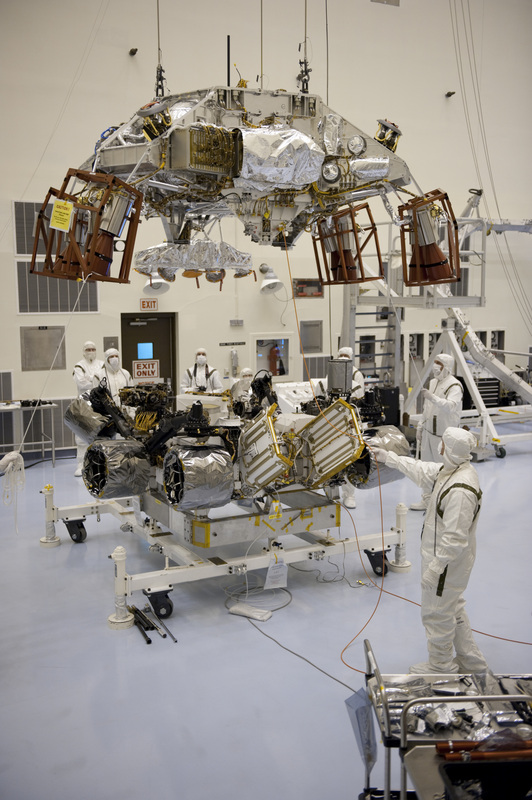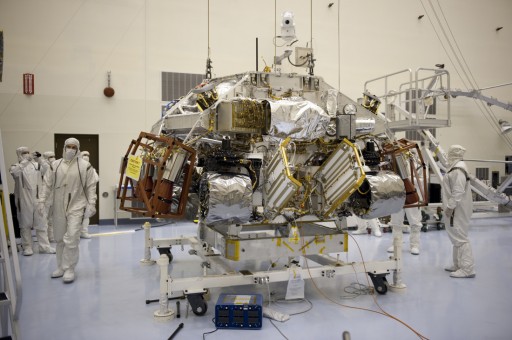MSL – Descent Stage and Sky Crane

The MSL Descent Stage and Sky Crane System are responsible for the final part of the Entry, Descent and Landing Mission Phase performing the powered descent maneuver and the Curiosity Landing as well a Flyaway Maneuver.
The MSL Descent Stage includes an independent Systems such as electric, data and propulsion systems necessary to perform its descent to the Martian Surface. The Descent Stage does not include an actual flight computer since the MSL Rover provides Guidance and Control with its Control Systems, however, the Descent Stage includes a Descent Controller that is required for autonomous operations. The Descent Stage has a Propulsion System consisting of a Main Propulsion System and Reaction Control System.
The Main Propulsion System features 8 Mars Landing Engines. These engines will be used for the powered descent to the Martian Surface. Each of the engines uses Hydrazine Propellant and has a throttle range of 400 Newtons to 3,060 Newtons. The engines can operate at a near shutdown level with about 1% of the maximum propellant flow. Eight Engines will be used during the initial portion of the descent before four of them enter the near shutdown level condition to function as back ups. The Descent Stage Reaction Control System features eight thrusters that are used pre-entry, during entry, while flying under the parachute and during the powered descent as well as the flyaway. 390 Kilograms of Propellants are stored inside four Hydrazine Tanks. Propellant margins for the EDL Portion of the flight are tight.

During a perfect landing scenario, 298 Kilograms of Hydrazine would be consumed by the Mars Landing Engines – not taking RCS Consumption into account. The descent stage also features avionics equipment. Two Descent Inertial Measurement Units are part of the system. These make precise measurements of the vehicle attitude during Entry, Descent and Landing and provide navigation information to the Control System. One Terminal Descent Sensor is deployed following backshell separation. This sensor is capable of measuring terrain relative velocity with high precision utilizing pulse doppler radar. Six independent beams (3 beams canted 20 deg. Off nadir, 2 beams canted 50 deg. Off nadir, and one nadir beam) which provide range and velocity data for the area below the vehicle so that an exact landing zone profile can be created in real time. The TDS uses Ka-Band frequency. The descent stage includes an electrical system consisting of two non-redundant thermal batteries. 27-37 Volts of power are provided by the two batteries following cruise stage separation. Two 26-36V batteries are used for Pyro Initiation. The bus voltage is controlled by the two main batteries and pyro bus A and B voltage is controlled by the Pyro Batteries which form a redundant system.
The Sky Crane Equipment is included in the Descent Stage. Once reaching an altitude of 19 meters, the Curiosity Rover separates from the Descent Stage and is lowered by three Bridles. These bridles are 7.5 meters in length. Also part of the system is an electrical and data umbilical cord that is used to allow the Rover to communicate with the descent stage. Also, the descent stage will provide power to Curiosity until the last second. While flying on the Sky Crane, the Rover transitions from its stowed configuration to its deployed state. Once touchdown has occurred, several pyrotechnic wire cutters are initiated to separate the the Rover from the Descent Stage that then throttles up and performs the Flyaway Maneuver.
